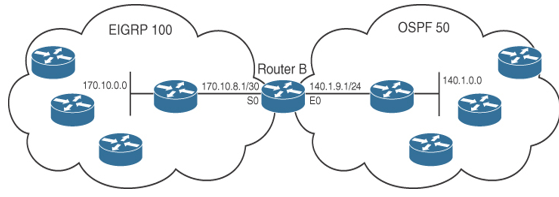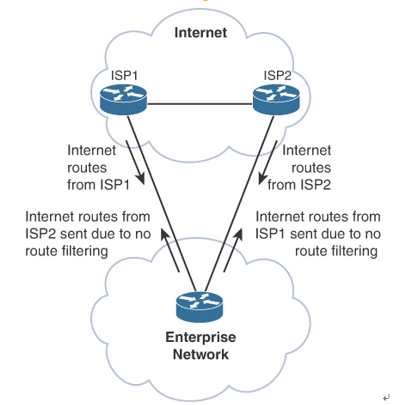Default Metric – OSPF, BGP, and Route Manipulation
You should configure the metric of the redistributed routes to a metric other than 0. You can configure the metric in the redistribution command or configure a default seed metric. You can also use the command default-metric with OSPF. IS-IS does not use the default-metric command. The default-metric command is used to specify the seed metric that is used if a metric is not specified during redistribution. The default-metric command has the following syntax for EIGRP:
default-metric
bandwidth delay reliability load mtu
OSPF Redistribution
This section reviews a few things you need to remember when designing a network that will redistribute with OSPF.
When redistributing routes into OSPF, use the subnets keyword to permit subnetted routes to be received. If you do not use it, only the major network route is redistributed, without subnetworks. In other words, OSPF performs automatic summarization to IP classful network values. Also, unlike EIGRP and RIPv2, OSPF does not need a metric to be specified during redistribution; it also does not need a seed metric to be specified because it uses a default metric for redistributed routes.
By default, redistributed routes are classified as external Type 2 (E2) in OSPF. You can use the metric-type keyword to change the external route to an external Type 1 (E1). The network design can take into account the after-redistribution cost (Type 2) or the after-redistribution cost plus the path’s cost (Type 1).
In Figure 4-24, Router B is configured to perform mutual redistribution between EIGRP 100 and OSPF process ID 50. In this example, you can use route maps and access lists to prevent routing loops. The route maps permit or deny the networks that are listed in the access lists. The subnets keyword redistributes every subnet in EIGRP into OSPF. (This book does not cover exact configurations.)

Figure 4-24 OSPF and EIGRP Redistribution
Route Filtering
Filtering of routes can occur either on a redistribution point or in the routing domain to prevent some parts of the network from accessing other sections of the network. Route filtering could be used to filter routes when redistributing between routing protocols.
Filtering at a redistribution point provides the following benefits:
- Avoids routing loops
- Avoids suboptimal routing
- Prevents certain routes from entering the domain
Transit Traffic
With BGP, you should be sure not to configure a network as a transit network between autonomous systems. A transit network can occur when connecting your enterprise network to two ISPs in a multihomed BGP configuration. When BGP routes get exchanged with multiple Internet service providers (ISPs), route filtering is used to prevent advertisement of private addresses and addresses that are out of the scope of the domain. The recommendation is to filter routes so that only the enterprise prefixes are advertised to the ISPs, as illustrated in Figure 4-25.

Figure 4-25 Avoiding BGP Transit Traffic
